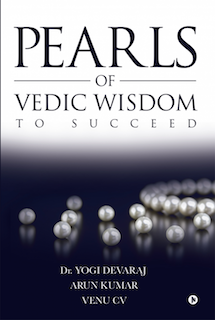Drig-Drishya Viveka (Seer-Seen Enquiry) is an enquiry into the distinction of the Seer (Drig) and the Seen (Drishya), the Knower and the Known, the Witness and the Witnessed. This is considered as one of the most important pieces of work in the Vedic literature and contains just forty-six slokas (verses).
Certain verses of Katha Upanishad (2.6.7) and Bhagawad Gita (3.42) convey the essence of Drig-Drishya-Viveka. In the book “Drig-Drishya Viveka”, in the very first sloka itself the entire Viveka is explained.
The witness witnesses the scene, the witness is distinctly different from the scene and the witness is never affected by the scene. This is the nature of the witness which we all are aware of.
When the eyes see various objects, the pair of eyes is the seer and the objects are the seen. We can also say the eyes are the witness and the objects are the witnessed.
Just like the eyes, all other Jnanedriyas (sense organs) ear, skin tongue and nose are the perceivers and the respective sense objects are the perceived.
Drig-Drishya-Viveka further explains that eyes and other sense organs are pretty much useless without the MIND being present. The mind is very much required to process the input provided by the eyes. In this case, the mind is the witness and the various inputs provided by the eyes as well as other sense organs are the witnessed.
Let us continue the exploration further. The mind continuously processes numerous inputs and incessantly generates various thoughts. Though the mind undergoes these various modifications we are also conscious of the mind’s activities. This Consciousness or the Self is the SAKSHI (Witness) and the various activities and thoughts of the mind are the witnessed.
The Atman (Self) is never witnessed or perceived by any other entity. The Atman (Self) is Swayamprakasha (self-luminous) and does not undergo any change but witnesses all the changes and modifications of the mind. This Witnessing Consciousness does not rise, nor does it set; It does not increase, nor does it decrease; It shines by itself without any external aid.
The Atman (Self) powers the mind and we use the mind for all kinds of thoughts. In this noise of thoughts, the Self gets hidden and acts as a mute witness. When this noise is eliminated with indifference to the thoughts, the mind becomes absolutely quiet. With such a quiet mind if there is a steadfast single-pointed concentration on the Self, then the mind allows the Atman (Self) to be experienced. Just like we as a third person observe something outside, in the same way, we need to observe our own mind.
For example, when I am angry, I may be completely involved in that emotion and shouting at somebody angrily. At that moment I am also aware that I am angry. That Awareness is not involved or affected by the anger and acts as a mute witness.
I may be watching an interesting movie and be completely immersed in it. Yet I am conscious that I am watching a movie. That Consciousness is completely dispassionate and not involved or affected by the movie and acts as a mute witness.
Similarly, I may be playing a game and be totally engrossed in it. Still, I am conscious that I am playing a game. That Consciousness is not involved or affected by the happenings of the game and acts as a mute witness.
Thus, in every activity, whether I am happy, sad, angry, cheerful, suffering, etc. I may be completely involved in that emotion, yet at the same time I am also aware of the state of my mind. This Awareness is the Silent Witness, which never changes, is ever present and is not affected by any emotion.
On a screen when a movie is projected, one gets to see all kinds of scenes which are happy, sad, horrifying, etc. Though the screen is the substratum onto which the movie was projected, the screen just remains as a witness and is unaffected by the happenings in the movie. In the same way, our Awareness is the witness to all our emotions of the mind and activities of the body and remains unaffected by them.
If thoughts, desires and emotions arising in the mind are cognised as objects, then they become the seen and the seer of these thoughts is the Awareness which is the ever-present Sakshi (Witness).
A calm and quiet mind is required to fully experience the Silent Awareness and I have explained how exactly to achieve it in my answer to the question How can I attain self-realization according to Ramana Maharshi?
Drig-Drishya-Viveka emphasises that we need to be disinterested in the Drishya (seen) and desire to always be constantly delighted in the Drig (seer) which is nothing but experiencing the Sentient Life Energy by being in Silent Awareness.
You might also be interested in knowing What is Chit-Jada Granthi (Sentient-Insentient Knot) mentioned by Sri Ramana Maharshi?
See Also:


Post a Comment
Post a Comment